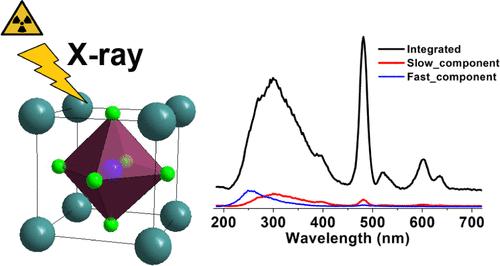掺杂 Pr3+ 的 LiBaF3 晶体的发光特性
IF 4.7
2区 化学
Q1 CHEMISTRY, INORGANIC & NUCLEAR
引用次数: 0
摘要
开发新型荧光粉的研究正在进行中,该荧光粉能够发射从紫外(UV)到红外区域的广谱光,具有在不同领域的潜在应用。采用固相反应的方法,制备了一系列liaf3:Pr3+荧光粉,研究了它们在紫外可见范围内的发光性能。在Pr3+的4f5d波段激发下,观察到光子级联发射(PCE)现象。研究了LiBaF3:Pr3+在40 keV x射线激发下的光谱和动力学发光特性。LiBaF3:Pr3+的x射线激发发光光谱由Pr3+离子的发射、自捕获激子的发射和LiBaF3宿主的核价发光组成。此外,本研究在83-563 K的温度范围内评估了LiBaF3:Pr3+的光学测温性能,揭示了在生理范围内的温度传感潜力。本研究不仅描述了新合成的LiBaF3:Pr3+的发光特性,还探讨了其作为快速紫外闪烁体和光学温度传感器的潜在应用。本文章由计算机程序翻译,如有差异,请以英文原文为准。

Luminescent Properties of Pr3+-Doped LiBaF3 Crystallites
Research is ongoing to develop new phosphors capable of emitting light across a broad spectrum, ranging from the ultraviolet (UV) to the infrared region, with potential applications in diverse fields. Using the method of solid-state reactions, a series of LiBaF3:Pr3+ phosphors were obtained, and their luminescent properties in the UV–visible range were studied. The photon cascade emission (PCE) phenomenon has been observed under excitation of the 4f5d bands of Pr3+. The spectral and kinetic luminescent characteristics of LiBaF3:Pr3+ under X-ray excitation (40 keV) were studied. The X-ray excited luminescence spectrum of LiBaF3:Pr3+ consists of the emission of Pr3+ ions, the emission of self-trapped excitons, and the core–valence luminescence of the LiBaF3 host. In addition, the study assessed the optical-thermometric properties of LiBaF3:Pr3+ in the temperature range of 83–563 K, revealing the potential of temperature sensing in the physiological range. This study not only describes the luminescent properties of the newly synthesized LiBaF3:Pr3+ but also explores its potential applications as a fast ultraviolet scintillator and an optical temperature sensor.
求助全文
通过发布文献求助,成功后即可免费获取论文全文。
去求助
来源期刊

Inorganic Chemistry
化学-无机化学与核化学
CiteScore
7.60
自引率
13.00%
发文量
1960
审稿时长
1.9 months
期刊介绍:
Inorganic Chemistry publishes fundamental studies in all phases of inorganic chemistry. Coverage includes experimental and theoretical reports on quantitative studies of structure and thermodynamics, kinetics, mechanisms of inorganic reactions, bioinorganic chemistry, and relevant aspects of organometallic chemistry, solid-state phenomena, and chemical bonding theory. Emphasis is placed on the synthesis, structure, thermodynamics, reactivity, spectroscopy, and bonding properties of significant new and known compounds.
 求助内容:
求助内容: 应助结果提醒方式:
应助结果提醒方式:


